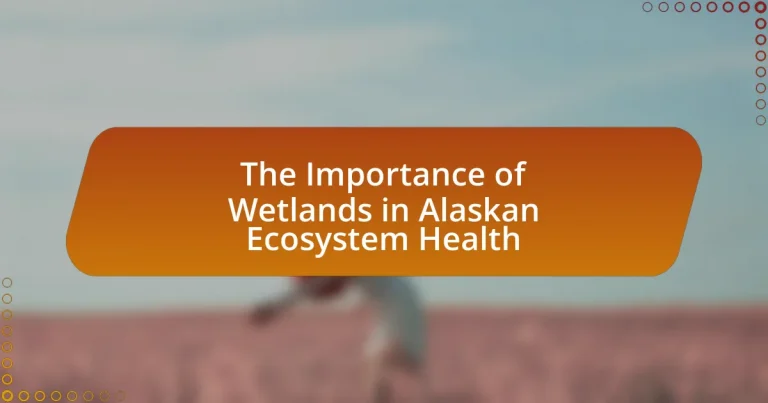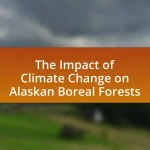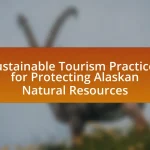Wetlands are vital ecosystems in Alaska, covering approximately 175 million acres and representing about 50% of the state’s land area. They provide essential services such as habitat for diverse wildlife, including migratory birds and fish, water filtration, flood regulation, and carbon storage, which helps mitigate climate change. The article explores the characteristics and functions of Alaskan wetlands, their role in supporting biodiversity, the threats they face from climate change and human activities, and the conservation efforts in place to protect these critical habitats. Additionally, it highlights the importance of local communities and organizations in wetland preservation and outlines best practices for sustainable land use near these ecosystems.
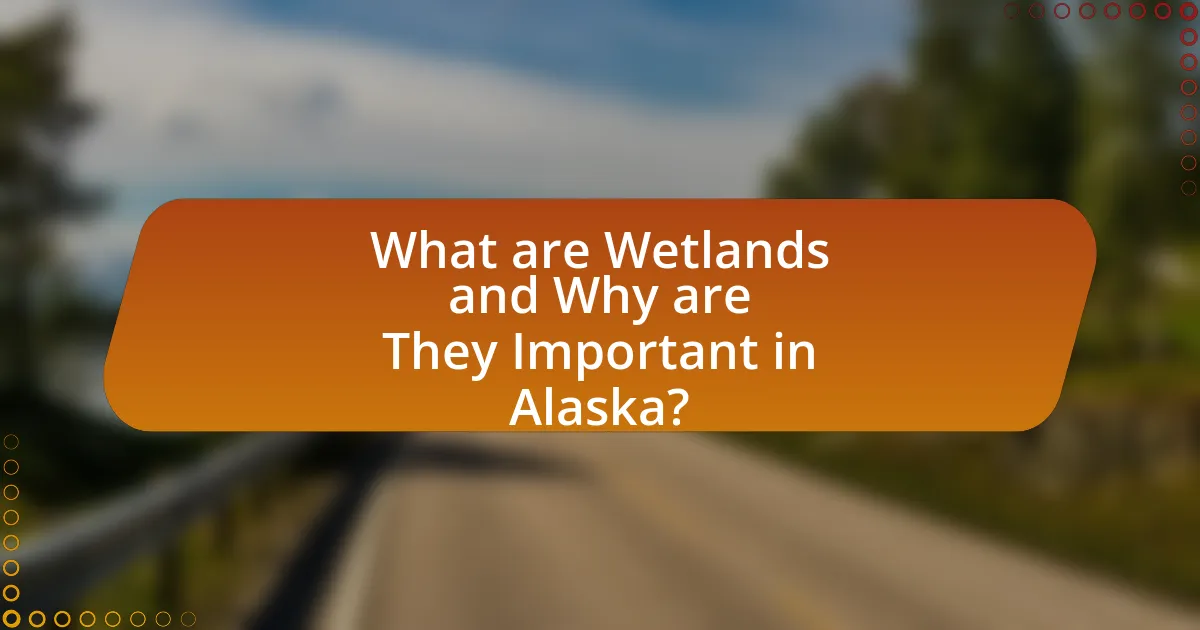
What are Wetlands and Why are They Important in Alaska?
Wetlands are ecosystems characterized by saturated soils and waterlogged conditions, supporting diverse plant and animal life. In Alaska, wetlands play a crucial role in maintaining ecosystem health by providing habitat for wildlife, including migratory birds and fish, and acting as natural water filters that improve water quality. Additionally, they store carbon, helping to mitigate climate change effects, and regulate water flow, reducing flood risks. According to the U.S. Fish and Wildlife Service, Alaska contains approximately 175 million acres of wetlands, which represent about 50% of the state’s land area, highlighting their significance in the Alaskan landscape and ecology.
How do Wetlands Function within the Alaskan Ecosystem?
Wetlands function as critical components of the Alaskan ecosystem by providing essential services such as water filtration, habitat for diverse species, and flood regulation. These ecosystems filter pollutants from water, improving water quality and supporting aquatic life. In Alaska, wetlands serve as breeding and nesting grounds for migratory birds and other wildlife, contributing to biodiversity. Additionally, they play a vital role in carbon storage, helping to mitigate climate change effects. According to the U.S. Fish and Wildlife Service, Alaska’s wetlands cover approximately 175 million acres, highlighting their significance in maintaining ecological balance and supporting local communities.
What are the key characteristics of Alaskan wetlands?
Alaskan wetlands are characterized by their diverse ecosystems, hydrology, and unique vegetation. These wetlands support a variety of plant and animal species, including migratory birds and fish, due to their rich nutrient availability and waterlogged conditions. The hydrology of Alaskan wetlands is influenced by seasonal thawing and freezing, which creates dynamic water levels that vary throughout the year. Additionally, the presence of permafrost in many areas affects drainage and contributes to the formation of distinct wetland types, such as marshes, swamps, and bogs. These characteristics are crucial for maintaining biodiversity and providing essential ecosystem services, such as water filtration and flood control.
How do wetlands interact with other ecosystems in Alaska?
Wetlands in Alaska interact with other ecosystems by serving as critical habitats for diverse wildlife, regulating water quality, and influencing local hydrology. These ecosystems provide breeding grounds for fish and migratory birds, which rely on wetlands for food and shelter. Additionally, wetlands filter pollutants and sediments from water, improving the quality of adjacent rivers and lakes. They also play a vital role in the hydrological cycle by absorbing excess rainfall and releasing water slowly, which helps maintain stream flows during dry periods. Studies have shown that wetlands contribute to the overall biodiversity and resilience of Alaskan ecosystems, highlighting their importance in maintaining ecological balance.
What Role do Wetlands Play in Biodiversity in Alaska?
Wetlands in Alaska are crucial for maintaining biodiversity as they provide essential habitats for a wide variety of species. These ecosystems support over 200 species of birds, numerous fish species, and various mammals, including moose and bears, which rely on wetlands for food and shelter. Additionally, wetlands act as nurseries for fish, particularly salmon, which are vital to both the ecological balance and the economy of Alaska. The unique hydrology and vegetation of wetlands contribute to nutrient cycling and water filtration, further enhancing the habitat’s capacity to support diverse life forms.
Which species depend on Alaskan wetlands for survival?
Numerous species depend on Alaskan wetlands for survival, including migratory birds, fish, and various mammals. Specifically, species such as the Pacific Black Brant, which relies on wetlands for nesting and feeding, and the Arctic Char, which uses these habitats for spawning, illustrate the critical role of wetlands. Additionally, mammals like the moose and beavers utilize wetland areas for food and shelter, highlighting the ecological significance of these environments in supporting diverse wildlife.
How do wetlands contribute to habitat diversity in Alaska?
Wetlands significantly contribute to habitat diversity in Alaska by providing a unique ecosystem that supports a wide range of plant and animal species. These areas serve as critical breeding, feeding, and migratory habitats for numerous wildlife, including waterfowl, fish, and terrestrial mammals. For instance, Alaska’s wetlands are home to over 200 species of birds, many of which rely on these habitats during migration and nesting seasons. Additionally, wetlands help maintain biodiversity by offering various microhabitats, such as open water, marshes, and peatlands, which cater to different species’ needs. The presence of diverse vegetation in wetlands also supports complex food webs, further enhancing habitat diversity.
What Ecosystem Services do Alaskan Wetlands Provide?
Alaskan wetlands provide critical ecosystem services including water filtration, flood regulation, carbon storage, and habitat for diverse wildlife. These wetlands filter pollutants from water, improving water quality and supporting aquatic ecosystems. They also act as natural buffers, absorbing excess rainfall and reducing flood risks in surrounding areas. Furthermore, Alaskan wetlands sequester significant amounts of carbon, helping to mitigate climate change. Additionally, they serve as vital habitats for numerous species, including migratory birds and fish, contributing to biodiversity and supporting local fisheries.
How do wetlands improve water quality in Alaska?
Wetlands improve water quality in Alaska by acting as natural filters that trap pollutants and sediments. These ecosystems absorb excess nutrients, such as nitrogen and phosphorus, which can lead to harmful algal blooms in water bodies. Additionally, wetlands provide habitat for microorganisms that break down organic matter and contaminants, further enhancing water purification. Studies have shown that wetlands can reduce sediment loads by up to 90%, significantly improving the clarity and quality of water entering rivers and lakes.
What role do wetlands play in flood control and climate regulation?
Wetlands play a crucial role in flood control and climate regulation by acting as natural buffers that absorb excess rainfall and store water. This water retention capacity helps to mitigate flooding by slowing down runoff and reducing peak flow rates during heavy precipitation events. Additionally, wetlands contribute to climate regulation by sequestering carbon dioxide, thus helping to mitigate climate change effects. According to the U.S. Environmental Protection Agency, wetlands can store up to 1.5 billion tons of carbon annually, highlighting their significance in carbon management and climate stability.
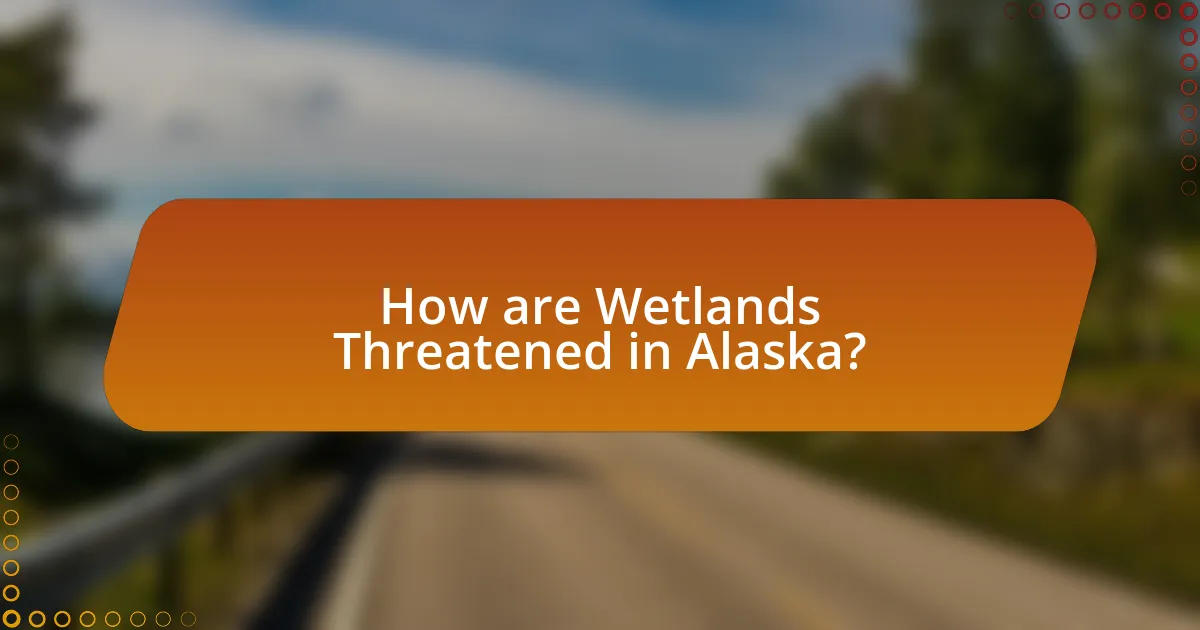
How are Wetlands Threatened in Alaska?
Wetlands in Alaska are threatened primarily by climate change, habitat destruction, and pollution. Climate change leads to rising temperatures and altered precipitation patterns, which can disrupt the hydrology of wetlands. Habitat destruction occurs through development, agriculture, and resource extraction, resulting in the loss of wetland areas. Pollution from industrial activities and runoff introduces harmful substances into these ecosystems, further degrading their health. According to the U.S. Environmental Protection Agency, Alaska has lost approximately 50% of its historical wetlands, underscoring the critical threats they face.
What are the main threats to Alaskan wetlands?
The main threats to Alaskan wetlands include climate change, oil and gas development, and invasive species. Climate change leads to altered hydrology and increased temperatures, which can disrupt the delicate balance of wetland ecosystems. Oil and gas development poses risks through habitat destruction and pollution, as seen in areas like the North Slope, where extraction activities have degraded wetland habitats. Invasive species, such as reed canary grass, outcompete native vegetation, further threatening the ecological integrity of these wetlands. These factors collectively jeopardize the biodiversity and functionality of Alaskan wetlands, which are crucial for wildlife habitat and water quality.
How does climate change impact wetland health in Alaska?
Climate change negatively impacts wetland health in Alaska by altering hydrology, increasing temperatures, and promoting invasive species. These changes lead to reduced biodiversity, habitat loss, and shifts in plant and animal communities. For instance, rising temperatures can cause permafrost thaw, which disrupts water flow and increases nutrient runoff, ultimately degrading wetland ecosystems. Additionally, studies indicate that invasive species, facilitated by warmer conditions, can outcompete native flora, further threatening the ecological balance of these vital habitats.
What human activities pose risks to wetlands in Alaska?
Human activities that pose risks to wetlands in Alaska include oil and gas exploration, mining, agriculture, and urban development. These activities lead to habitat destruction, pollution, and changes in hydrology, which adversely affect the delicate ecosystems of wetlands. For instance, oil spills from exploration can contaminate water sources and harm wildlife, while mining operations can result in sedimentation and habitat loss. Additionally, agricultural runoff introduces fertilizers and pesticides that degrade water quality, further threatening wetland health. Urban development often involves draining wetlands for construction, which disrupts natural water flow and diminishes biodiversity.
What are the Consequences of Wetland Loss in Alaska?
Wetland loss in Alaska leads to significant ecological and socio-economic consequences. The reduction of wetlands disrupts habitats for numerous species, including migratory birds and fish, which rely on these ecosystems for breeding and feeding. Additionally, the loss of wetlands contributes to increased flooding and erosion, as these areas play a crucial role in water absorption and shoreline stabilization. Furthermore, the degradation of wetlands can result in the release of stored carbon, exacerbating climate change. According to the U.S. Fish and Wildlife Service, Alaska has lost approximately 50% of its coastal wetlands, highlighting the urgent need for conservation efforts to mitigate these impacts.
How does wetland loss affect local wildlife populations?
Wetland loss significantly reduces local wildlife populations by destroying critical habitats essential for breeding, feeding, and shelter. For instance, in Alaska, wetlands support diverse species such as migratory birds, fish, and mammals that rely on these ecosystems for survival. The U.S. Fish and Wildlife Service reports that over 50% of Alaska’s wetlands have been lost due to human activities and climate change, leading to declines in species like the Pacific black brant and various salmon populations. This habitat degradation disrupts food chains and decreases biodiversity, ultimately threatening the ecological balance within the region.
What are the implications for water quality and flood management?
Wetlands play a crucial role in maintaining water quality and managing floods. They act as natural filters, trapping pollutants and sediments, which improves the overall quality of water that flows into rivers and lakes. For instance, studies have shown that wetlands can remove up to 90% of nitrogen and phosphorus from water, thus preventing harmful algal blooms and promoting healthier aquatic ecosystems. Additionally, wetlands provide flood management by absorbing excess rainfall and reducing runoff, which mitigates the risk of flooding in surrounding areas. Research indicates that areas with extensive wetland coverage experience lower flood peaks, demonstrating their effectiveness in flood control.
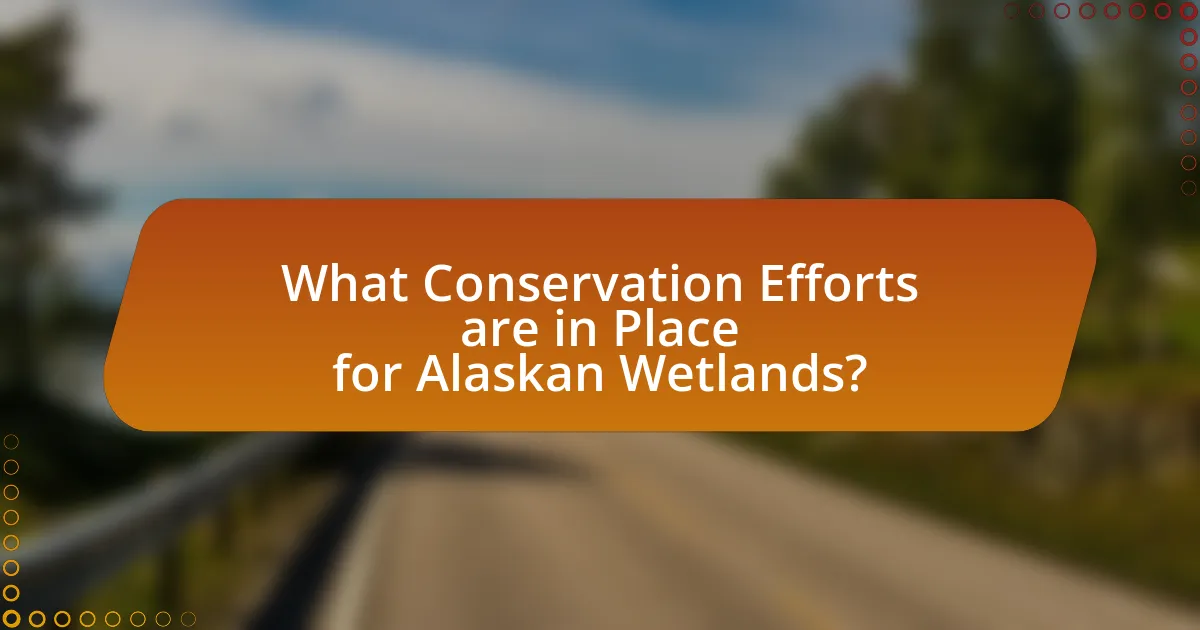
What Conservation Efforts are in Place for Alaskan Wetlands?
Conservation efforts for Alaskan wetlands include the establishment of protected areas, regulatory frameworks, and restoration projects. The U.S. Fish and Wildlife Service manages numerous national wildlife refuges that safeguard wetland habitats, while the Clean Water Act regulates discharges into these ecosystems to prevent pollution. Additionally, organizations like The Nature Conservancy engage in habitat restoration initiatives aimed at rehabilitating degraded wetlands. These efforts are crucial, as Alaskan wetlands provide essential services such as carbon storage, water filtration, and habitat for diverse wildlife, contributing significantly to the overall health of the Alaskan ecosystem.
How are Alaskan wetlands being protected and restored?
Alaskan wetlands are being protected and restored through a combination of regulatory measures, conservation programs, and community involvement. The U.S. Army Corps of Engineers and the Environmental Protection Agency enforce the Clean Water Act, which regulates activities that could impact wetlands. Additionally, initiatives like the Alaska Wetlands Conservation Strategy aim to enhance wetland management and restoration efforts. Community-based projects, such as those led by local tribes and conservation organizations, focus on habitat restoration and education to promote sustainable practices. These efforts are crucial, as wetlands in Alaska provide essential ecosystem services, including water filtration, flood control, and habitat for diverse wildlife.
What role do local communities play in wetland conservation?
Local communities play a crucial role in wetland conservation by actively participating in management practices and restoration efforts. Their traditional ecological knowledge and vested interest in local resources enable them to implement sustainable practices that protect wetland ecosystems. For instance, studies have shown that community-led initiatives, such as the Kachemak Bay Conservation Society in Alaska, effectively engage residents in monitoring and preserving wetland habitats, leading to improved biodiversity and ecosystem health. Additionally, local communities often advocate for policies that prioritize wetland conservation, demonstrating their integral role in safeguarding these vital ecosystems.
Which organizations are involved in wetland preservation efforts?
Numerous organizations are involved in wetland preservation efforts, including the U.S. Fish and Wildlife Service, The Nature Conservancy, and Ducks Unlimited. The U.S. Fish and Wildlife Service plays a critical role in managing and protecting wetland habitats through various conservation programs and initiatives. The Nature Conservancy focuses on preserving natural habitats, including wetlands, by implementing science-based strategies and partnerships. Ducks Unlimited is dedicated to the conservation of North America’s waterfowl habitats, which includes extensive wetland restoration and protection efforts. These organizations collectively contribute to the health and sustainability of wetland ecosystems, particularly in regions like Alaska, where wetlands are vital for biodiversity and ecosystem services.
What Best Practices Can Support Wetland Health in Alaska?
Best practices that can support wetland health in Alaska include implementing conservation strategies, restoring degraded wetlands, and monitoring water quality. Conservation strategies, such as establishing protected areas and regulating land use, help preserve existing wetlands and their biodiversity. Restoration efforts, including replanting native vegetation and removing invasive species, can rehabilitate damaged wetlands, enhancing their ecological functions. Regular monitoring of water quality ensures that pollutants are identified and managed, maintaining the health of wetland ecosystems. These practices are essential for sustaining the vital roles wetlands play in Alaska’s ecosystem, such as flood control, water filtration, and habitat provision.
How can individuals contribute to wetland conservation?
Individuals can contribute to wetland conservation by participating in local restoration projects and advocating for policies that protect wetland areas. Engaging in activities such as planting native vegetation, removing invasive species, and volunteering with organizations focused on wetland health directly supports ecosystem restoration. According to the U.S. Environmental Protection Agency, wetlands provide critical habitat for wildlife, improve water quality, and help mitigate flooding, highlighting the importance of individual actions in preserving these ecosystems.
What are effective strategies for sustainable land use near wetlands?
Effective strategies for sustainable land use near wetlands include implementing buffer zones, promoting low-impact development, and restoring native vegetation. Buffer zones, typically 100 to 300 feet wide, help filter pollutants and reduce runoff into wetlands, thereby protecting water quality. Low-impact development techniques, such as permeable pavements and green roofs, minimize impervious surfaces, allowing for natural water absorption and reducing flooding risks. Additionally, restoring native vegetation enhances biodiversity and stabilizes soil, which is crucial for maintaining the ecological integrity of wetlands. These strategies are supported by research indicating that well-managed land use can significantly mitigate negative impacts on wetland ecosystems, as demonstrated in studies conducted by the U.S. Environmental Protection Agency.
